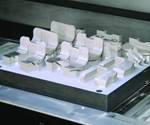Additive Manufacturing’s Opportunity in One Word
I want to say just one word to you: brackets.
There’s that scene in "The Graduate" in which a man advises the young Dustin Hoffman by saying, “I want to say just one word to you: plastics.” Having once been in my 20s, I can relate to how the Dustin Hoffman character was hoping for a more inspiring word about his future than this. Now that I’m in my 40s, I also understand that this man was giving him some pretty good advice.
If Dick Conrow was to have the same conversation with the young additive manufacturing industry, he might say, “I want to say just one word to you: brackets.”
Conrow (seen here) is president of C&A Tool, a CNC machining business that recently committed to developing in-house additive metal manufacturing expertise. The shop currently has four EOS direct metal laser sintering machines, with more likely to be added. This technology represents the way manufacturing is headed, he says. However, he is convinced that today’s users of the technology are missing some of the best opportunities it offers.
Additive manufacturing’s proponents are too focused on attractive parts characterized by fluid forms or organic shapes, he says. Parts such as these are fine—but additive manufacturing’s real promise lies in mundane components. For example, additive manufacturing now makes it easy to produce brackets in seemingly odd forms that simplify the assembly and function of engineered structures. Forget the curvaceous forms for a minute, Conrow says. When enough engineers learn to rethink their bracketry, this technology will take off.
Related Content
-
The Connector Conundrum: 3D Printed Mold Tooling’s Role in Innovation
ReelView Fishing faced an electronics obstacle in the development of its new technology for underwater video. Additive manufacturing for moldmaking allowed for the speed necessary to iterate to a solution. How inventors and invention will benefit from new ways of obtaining production-ready tooling.
-
In "Hybrid" FIM Process, 3D Printing Complements Injection Molding
In a recent case study, Alpine Advanced Materials partnered with Nexa3D to produce 3D printed tooling for injection molded composites. Utilizing Nexa3D’s XiP desktop 3D printer and its Freeform Injection Molding process, Alpine was able to reduce prototype tooling production time and cost alike for its customers.
-
3D Printing Molds With Metal Paste: The Mantle Process Explained (Video)
Metal paste is the starting point for a process using 3D printing, CNC shaping and sintering to deliver precise H13 or P20 steel tooling for plastics injection molding. Peter Zelinski talks through the steps of the process in this video filmed with Mantle equipment.











